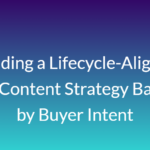Why Lifecycle Marketing Demands Intent Alignment
In 2025, lifecycle marketing has become essential for B2B brands seeking sustained engagement and conversion. From lead acquisition to post-sale growth, content must speak to the evolving needs of the buyer. A successful B2B Content Strategy leverages intent signals to adapt across each lifecycle stage awareness, consideration, decision, onboarding, and expansion.
When content aligns with where a buyer is in their journey, it not only improves engagement but also shortens sales cycles, reduces churn, and increases customer lifetime value. The secret is integrating buyer intent into every content decision.
Stage 1: Awareness — Creating Content That Gets Found
At the top of the lifecycle, your B2B Content Strategy should focus on visibility and education. Buyers here are problem-aware but not yet solution-ready. They’re searching Google, browsing LinkedIn, and consuming general industry content.
This stage calls for SEO-optimized blogs, explainer videos, industry trend reports, and infographics. Content should address pain points, ask important questions, and offer non-promotional value. Buyer intent signals like keyword searches and content downloads guide which topics to prioritize. The goal: earn trust and drive organic discovery.
Stage 2: Consideration — Delivering Deeper Content Experiences
As buyers signal stronger intent such as engaging with specific blog categories, subscribing to newsletters, or registering for events they enter the consideration stage. Here, a smart B2B Content Strategy goes beyond awareness and focuses on solutions.
eBooks, product comparison guides, webinars, and gated whitepapers help educate and differentiate. Tailor content by vertical, role, and pain point using segmentation. Use behavioral triggers to personalize delivery—for example, showing a relevant webinar after a pricing page visit. This stage is all about relevance and depth.
Stage 3: Decision — Equipping Buyers for Internal Alignment
Decision-stage buyers often need to convince internal stakeholders, secure budget, and assess vendor risk. Your B2B Content Strategy should now provide bottom-funnel content designed to reduce friction and facilitate purchasing.
Include ROI calculators, case studies with measurable outcomes, customer testimonials, interactive demos, and executive briefing decks. Ensure sales and marketing are aligned on messaging. Intent signals like time spent on product pages, demo requests, or repeated visits can trigger this content dynamically, ensuring you deliver exactly what’s needed at the right moment.
Stage 4: Onboarding — Supporting Early Success
Once the sale is made, the content journey shouldn’t stop. Onboarding is a critical part of the lifecycle, and your B2B Content Strategy must support it. Content here builds confidence and encourages adoption.
Onboarding videos, how-to tutorials, user guides, implementation checklists, and first-30-days playbooks ensure customers are empowered from the start. Triggered email sequences based on product usage patterns help reinforce value and reduce early churn. Content aligned with intent at this stage enhances the customer experience and drives faster time-to-value.
Stage 5: Adoption — Encouraging Deeper Engagement
Customers who begin to use your product or service actively are ripe for nurturing. This part of the lifecycle is about encouraging feature discovery and deepening engagement. A robust B2B Content Strategy identifies intent signals—like support searches or repeated logins—and responds with the right enablement materials.
Send relevant tips, advanced feature tutorials, user stories, and community highlights. Host webinars and events around product mastery or best practices. Celebrate milestones and show value evolution over time. This keeps your solution top-of-mind and supports ongoing customer success.
Stage 6: Expansion — Enabling Cross-Sell and Upsell Conversations
Once trust is established and product value is evident, expansion becomes the natural next step. Your B2B Content Strategy must now turn its focus to growth within accounts. Pay attention to intent signals such as increased usage, added team members, or engagement with pricing pages for other products.
Serve up content like customer success stories from similar verticals, upgrade guides, product comparison sheets, and personalized ROI forecasts. Work closely with customer success and account managers to ensure content supports live conversations. The right content here drives revenue without feeling like a hard sell.
Stage 7: Advocacy — Turning Customers into Champions
The final lifecycle stage is often overlooked: advocacy. A high-performing B2B Content Strategy empowers customers to share their success and influence others. Intent signals—like submitting a positive NPS score or attending multiple events—can flag ideal advocates.
Offer content opportunities like co-branded case studies, speaking engagements, testimonial interviews, and referral program assets. Enable advocates with social share kits and ready-made templates. These champions add authenticity to your brand and can help fuel new business at lower acquisition costs.
Personalization Across the Lifecycle
Lifecycle content only works when it’s personalized. Intent signals vary by role, industry, company size, and funnel position. Smart B2B Content Strategy tools now integrate CRM data, behavioral analytics, and third-party signals to auto-adjust content based on these variables.
A marketing director and a procurement lead from the same account might see different emails, CTAs, or landing page modules—all powered by their individual behavior. This level of personalization creates seamless, relevant experiences that improve engagement and reduce drop-off.
Operationalizing Lifecycle Content with Automation
Delivering the right content at every stage requires more than good writing—it requires a structured system. Your B2B Content Strategy should be supported by automation platforms that map content to journeys, track intent, and trigger distribution across channels.
Build nurture tracks, re-engagement flows, and success campaigns that reflect real lifecycle stages. Audit and refresh these assets quarterly to ensure they stay aligned with buyer behavior and product positioning. Automation doesn’t replace human insight—it amplifies it at scale.
Read the Full Blog Now @ https://acceligize.com/featured-blogs/smart-b2b-content-strategy-aligned-with-buyer-intent/
About Us
Acceligize is a global leader in B2B demand generation and sales enablement, specializing in connecting businesses with highly targeted, ready-to-engage prospects. Through innovative digital marketing strategies, buyer intent data, and multi-touch campaigns, Acceligize empowers sales and marketing teams to drive growth, generate qualified leads, and achieve faster revenue outcomes. With a focus on accuracy, engagement, and scalability, Acceligize delivers real, measurable results to enterprises across industries.

